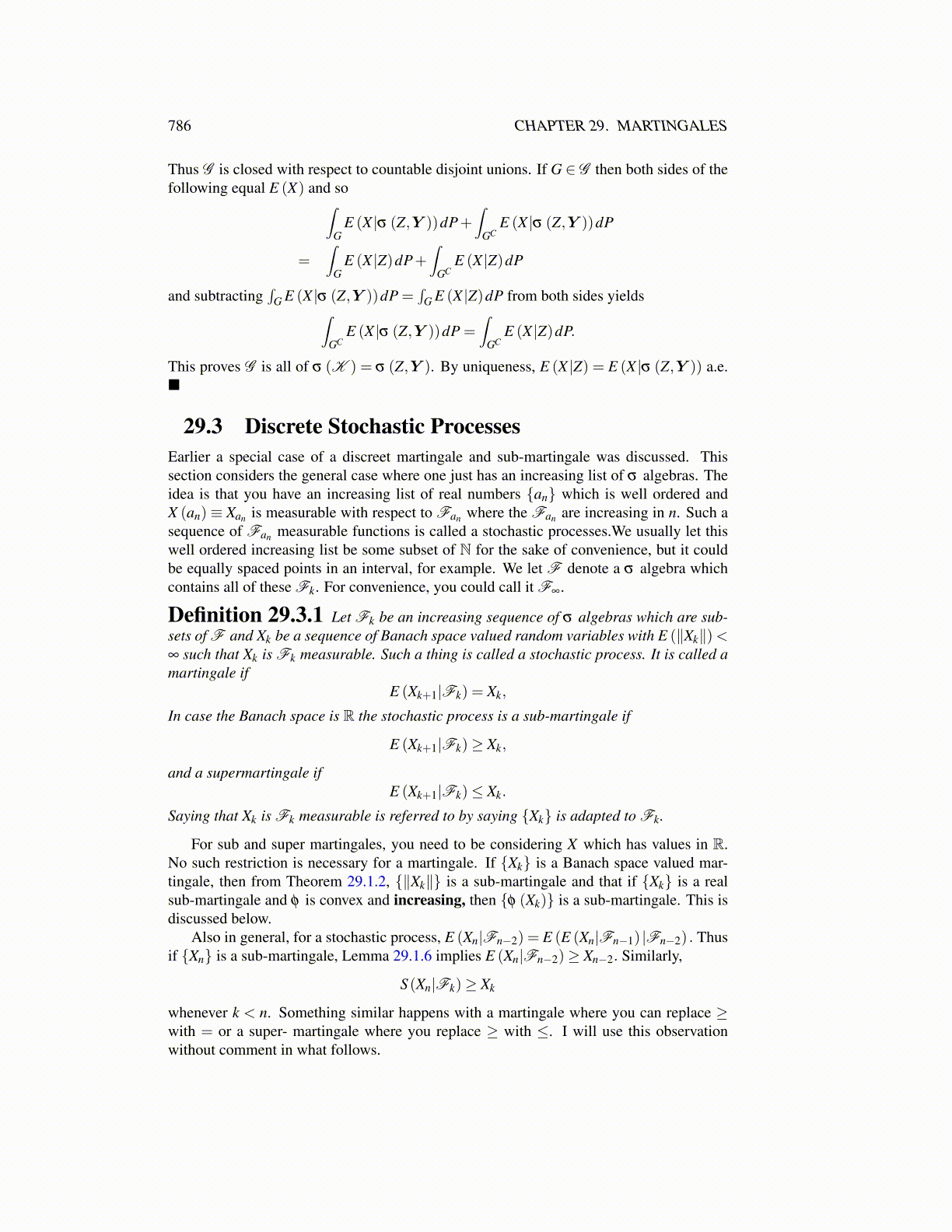
786 CHAPTER 29. MARTINGALES
Thus G is closed with respect to countable disjoint unions. If G ∈ G then both sides of thefollowing equal E (X) and so∫
GE (X |σ (Z,Y ))dP+
∫GC
E (X |σ (Z,Y ))dP
=∫
GE (X |Z)dP+
∫GC
E (X |Z)dP
and subtracting∫
G E (X |σ (Z,Y ))dP =∫
G E (X |Z)dP from both sides yields∫GC
E (X |σ (Z,Y ))dP =∫
GCE (X |Z)dP.
This proves G is all of σ (K ) = σ (Z,Y ). By uniqueness, E (X |Z) = E (X |σ (Z,Y )) a.e.■
29.3 Discrete Stochastic ProcessesEarlier a special case of a discreet martingale and sub-martingale was discussed. Thissection considers the general case where one just has an increasing list of σ algebras. Theidea is that you have an increasing list of real numbers {an} which is well ordered andX (an)≡ Xan is measurable with respect to Fan where the Fan are increasing in n. Such asequence of Fan measurable functions is called a stochastic processes.We usually let thiswell ordered increasing list be some subset of N for the sake of convenience, but it couldbe equally spaced points in an interval, for example. We let F denote a σ algebra whichcontains all of these Fk. For convenience, you could call it F∞.
Definition 29.3.1 Let Fk be an increasing sequence of σ algebras which are sub-sets of F and Xk be a sequence of Banach space valued random variables with E (∥Xk∥)<∞ such that Xk is Fk measurable. Such a thing is called a stochastic process. It is called amartingale if
E (Xk+1|Fk) = Xk,
In case the Banach space is R the stochastic process is a sub-martingale if
E (Xk+1|Fk)≥ Xk,
and a supermartingale ifE (Xk+1|Fk)≤ Xk.
Saying that Xk is Fk measurable is referred to by saying {Xk} is adapted to Fk.
For sub and super martingales, you need to be considering X which has values in R.No such restriction is necessary for a martingale. If {Xk} is a Banach space valued mar-tingale, then from Theorem 29.1.2, {∥Xk∥} is a sub-martingale and that if {Xk} is a realsub-martingale and φ is convex and increasing, then {φ (Xk)} is a sub-martingale. This isdiscussed below.
Also in general, for a stochastic process, E (Xn|Fn−2) = E (E (Xn|Fn−1) |Fn−2) . Thusif {Xn} is a sub-martingale, Lemma 29.1.6 implies E (Xn|Fn−2)≥ Xn−2. Similarly,
S (Xn|Fk)≥ Xk
whenever k < n. Something similar happens with a martingale where you can replace ≥with = or a super- martingale where you replace ≥ with ≤. I will use this observationwithout comment in what follows.